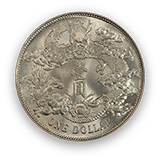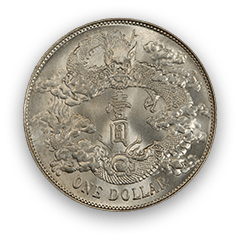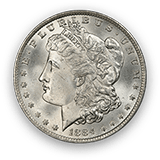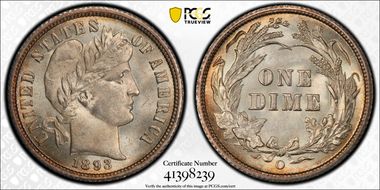Pearl Elizabeth Knight (1893-1972) 的钱币相册
The 1893 Indian Cent has an average mintage more or less. As there are several issues from the series which have significantly lower or higher mintages. This issue appears to be scarce in MS65 condition with no more than a few hundred known in this condition. In MS66 it is even scarcer with about 100 or so examples known. Anything grading higher is considered a condition census coin and less than a few dozen or so known grading higher than MS66.
The 1893 Liberty Head Nickel is one of a cluster of dates from 1887-1893 inclusive that all have similar mintmarks and survival rates. All are highly collectible, easily obtained, and often come with beautiful luster and eye appeal. However, unlike the others, this is a date that is very difficult to locate with all of the stars fully struck AND with a full ear of corn on the lower left reverse. At the top end of the condition ladder, PCGS has certified over two dozen MS66s and a single PCGS MS67.
Circulated grades: The 1893 is readily available in worn grades, but among Philadelphia Mint Morgan dollars the 1893 is one of the more elusive dates. Most circulation strike 1893 dollars are decent strikes but have somewhat "greasy" lustre, not a deep frosty surface. Others are lightly struck at the centers and often have dull lustre. Once again, cherrypicking for quality is advised. Lower range coins are apt to have smaller (less heavy or damaging) bagmarks than seen on many other Morgan dollars. Higher grade coins with minimum bagmarks are often found as well. Most coins known today are in lower ranges such as MS-60 to 62, of which probably 30,000 to 60,000 exist. MS-63 coins, with an estimated population of 10,000 to 20,000, are more elusive. Rarer still are MS-64s, of which possibly 4,000 to 8,000 survive. Rarest of all are MS-65 or better pieces, which exist to the extent of only 400 to 800 coins.
The 1893-CC $1 is an immensely popular coin because of its Mint of origin, the fact that it is the last of the CC Dollars, and because sufficient quantities remain to make it easy to obtain. The 1893-CC, along with the 1889-CC and the 1879-CC, is one of the three scarcest Morgan Dollars. Interestingly, the PCGS Population Report shows similar quantities of each, but breaking down the data shows dissimilar patterns. The 1889-CC is a great rarity in Mint State and is so valuable in all grades that thousands of circulated examples have been sent in for grading. The 1879-CC comes in two varieties (Clear and Capped Mintmarks) but, here again, a substantial percentage of submissions are of circulated examples. Not so with the 1893-CC, where the bulk of the population rests within the Mint State range. However, because of poor storage, the overall quality of the 1893-CC Dollars is lower than for both the 1879-CC and 1889-CC Dollars. The typical 1893-CC Dollar shows excessive bagmarks and sometimes comes weakly struck in the centers, as evidenced by flat hair over Liberty's ear and flat feathers on the eagle's breast. Gem 1893-CC Dollars are very rare, more so than the 1879-CC and 1889-CC, and the finest 1893-CC $1 is a single PCGS MS-66.
Low mintage: The 1893-O dollar posted the lowest mintage figure for any New Orleans Mint silver dollar of the Morgan design. A few bags of 1893-O dollars were paid out at face value from the Cash Room of the Treasury Building from about 1948 to 1955. These may have been released a few coins at a time, rather than in intact 1,000-coin bags. These furnished the source for dealers' stocks. Single-coin prices went as low as $5.50 to $7.50 during the 1950s, until about 1958-1959, when it was realized that even rolls were scarce. I have no record of bags of 1893-O being included in the 1962-1964 Treasury releases. In worn grades the 1893-O is fairly scarce, due to its low mintage. The 1893-O dollar is scarce in all Mint State grades and is rare in higher levels. Probably 1,500 to 3,000 MS-60 to 62 coins remain; about 600 to 1,200 MS-63 pieces; only 200 to 300 MS-64s; and a paltry 10 to 20 MS-65 or better examples. Most 1893-O dollars are lightly struck and have fair to average lustre. Some coins are lightly struck on the obverse center but are sharp on the reverse. Many are heavily bagmarked, especially on the obverse. Sharply struck coins exist and are rare in higher grades. Sharply struck MS-65 coins are among the rarest of all Morgan dollars. Once again, the connoisseur is advised to cherrypick for quality. "Investors should avoid this date," wrote Wayne Miller in 1982, apparently referring to the difficulty of finding quality pieces. Semi-prooflike 1893-O Morgan dollars are sometimes sold as prooflikes and, according to Wayne Miller, are often more attractive than full prooflikes. Prooflike coins are sometimes one-sided and have a mirror surface on the reverse only. Full prooflike coins are extremely rare. DMPL coins seem to be about two or three times rarer than PL, per the certification services. The "Proofs" in the Nygren and Andrus sales (1914, 1915), considering the prices ($1.90, $3.10) were probably DMPLs. That in the "Anderson Dupont" sale (1954), at $26, exceeded the price of most Philadelphia Proofs in that auction; was it something better? The coin is not now traced. Varieties Circulation strikes: 1. Normal date: Breen-5631. The five VAM varieties (from three obverses and two reverses out of 10 pairs of dies furnished) may well be the only ones; the other seven obverses furnished may well never have been used; the reverses were probably left over for later years. Dies prepared: Obverse: 10; Reverse: No new dies shipped; those used were left over from earlier years' use. 300,000; Delivery figures by month: January: 300,000; February-December: none. Coinage was suspended June 1. Estimated quantity melted: Relatively few Mint State coins. True proof-like coins are very rare; DMPL coins are rarer still. Usually seen lightly struck at the centers. Several bags were released in the 1950s and/or 1960s and, apparently, have all been distributed. The 1893-O dollar is the lowest mintage New Orleans Morgan dollar
Relatively common in all grades, including gem uncirculated. It is obvious that most examples of this date, and the later dates as well, saw very little circulation since almost every specimen encountered is AU or Unc., with choice examples predominating.
The 1893-CC is the last Half Eagle from this popular mint. It is also one of the most common, ranking in overall rarity with the 1882-CC, 1890-CC and 1892-CC. It is considerably more rare than the 1891-CC. Although most known specimens are circulated (VF and EF are typical) the 1893-CC is also available in strictly uncirculated condition. However, gem quality mint state pieces are very scarce.
The 1893-S is a moderately scarce date in all grades, although it is not as difficult to obtain in choice condition as the 1892-S or the four S Mint coins immediately following (1894-1897). It should not be grouped with the common dates of the series since it is really quite scarce in strictly uncirculated condition, and very scarce in gem condition.
The 1893 $10 has the dubious distinction of having the largest PCGS-certified population of any date in the entire 10 Liberty series (although the 1894 $10 is almost as plentiful). This was one of the dates exported in large quantities to European central banks by the United States government decades ago. Dealers began re-importing them back into America beginning in the late 1970's and 1980s, and the supply has been seemingly inexhaustible. One might expect a large number of Gems from such a large population, but such is not the case. Rather, the overall quality of this date is generally poor, with the vast majority of survivors appearing in MS61 and MS62, suggesting excessive handling and movement of the bags in which the coins were stored. Thus, out of a population of over 17,000 PCGS-certified Mint State examples, only four have earned the MS65 grade
The 1893 is a moderately scarce date, certainly much more scarce than most of the Philadelphia Mint Liberty Heads that follow. (The 1898, 1902, 1905 and 1906 are really the only exceptions.) A large percentage of the known examples of this date are uncirculated but, of course, EF and AU specimens are also known. Most of the uncs are heavily bagmarked MS-60 coins and so choice and gem quality pieces, especially the latter, are seldom encountered. This is yet another date that used to be rare in Unc. until substantial quantities were discovered in Europe in the 1960's.
The 1893-S is a moderately scarce date, comparable overall to the 1879-S, 1882-S, 1885-S, 1888-S, 1892-S, 1901-S and 1905-S. Uncs are available more than any other individual grade but choice and gem quality specimens are very scarce, especially gems. I have seen a few really superb examples of this date, the finest being the nearly perfect coin that is in a prominent Dallas bank collection.


































